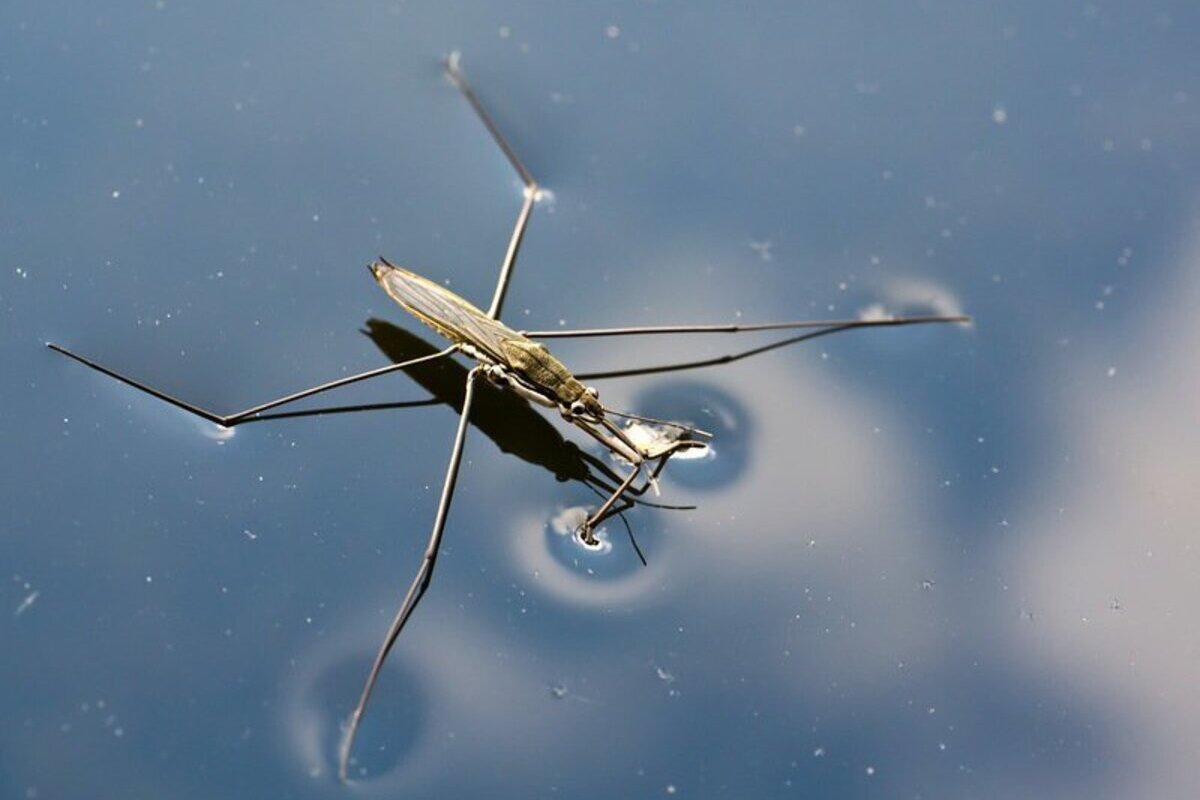Among the many tiny creatures that live near us, water striders hold a special place as masters of balance and survival. Though often unnoticed, they are a fascinating example of how biology and physics intertwine. Their ability to move effortlessly across the surface of water makes them a symbol of harmony between nature and physical laws. Below you will find interesting and amazing facts about water striders that you may not have known before.
- Water striders can walk on water thanks to surface tension, which supports their body weight. Their legs are covered in microscopic hairs that repel water, creating a thin layer of air beneath them. This allows the insects to stay afloat and move easily across ponds, streams, and even puddles.
- They have very long front and rear legs, which significantly increase the surface area in contact with the water. This body structure helps distribute their weight evenly. As a result, water striders do not break the water’s surface film that supports them.
- Water striders have specialized sensory organs that detect the slightest vibrations on the water’s surface. This helps them quickly locate prey or avoid danger. Even a single raindrop can create ripples that these insects detect instantly.
- They can reach speeds of up to one meter per second on the surface of the water. This is extremely fast for their size, as their bodies are typically no longer than two centimeters. Their movement looks like gliding or quick jumps propelled by their hind legs.
- Water striders feed primarily on small insects that fall into the water or float on its surface. They use a piercing-sucking mouthpart to draw fluids from their prey. They can also attack small aquatic invertebrates.
- Despite their delicate appearance, water striders are effective predators in their tiny ecosystems. They often hunt in groups, which improves their chances of success. Some species even show signs of coordinated hunting behavior.
- Water striders have excellent vision, allowing them to detect motion from a considerable distance. Their compound eyes give them a wide field of view, making it hard for prey to escape. They can spot potential food even before it lands on the water.
- Many species of water striders are capable of flight, although they rarely use this ability. They can fly to new bodies of water in search of better habitats or when their current environment dries up. Some species have both winged and wingless forms.
- Although they live on water, water striders breathe atmospheric oxygen rather than absorbing it from water. They rise to the surface and use spiracles on their abdomens to breathe. Their bodies are coated with a water-repellent layer that keeps them from getting wet.
- Around 1700 species of water striders are known worldwide, and they inhabit nearly every continent. The greatest diversity is found in tropical regions rich in freshwater sources. Some species can even be found in high altitudes or cooler climates.
- Some water striders are adapted to live in brackish or even salty waters, which is rare among insects. Their bodies are equipped with mechanisms to cope with high salt concentrations and avoid dehydration. These adaptations allow them to survive in coastal marine environments.
- Female water striders lay eggs on submerged plants or rocks near the water surface. The eggs have a sticky coating that helps them adhere to moist surfaces. Once hatched, the larvae undergo several molts before becoming adult insects.
- During dry periods, some water striders can enter a dormant state or remain in egg form until the water returns. This allows them to survive harsh conditions. Their eggs can remain viable for several months.
- Scientists study the movements of water striders to design robots that can walk on water. Laboratory prototypes that mimic surface tension-based locomotion have already shown promising results. These innovations are being considered for ecological monitoring of aquatic environments.
- In some folk traditions, water striders symbolize lightness, agility, and the ability to exist between two worlds. Their almost magical ability to avoid sinking has fascinated people for centuries. In some cultures, they are even considered symbols of good luck.
The world of water striders proves that even the smallest creatures can possess extraordinary traits and survival mechanisms. Their lives reflect a perfect combination of physics, biology, and adaptation. Studying such insects helps us better understand the harmony of the natural world. These interesting facts reveal just how rich and inspiring nature can be.





